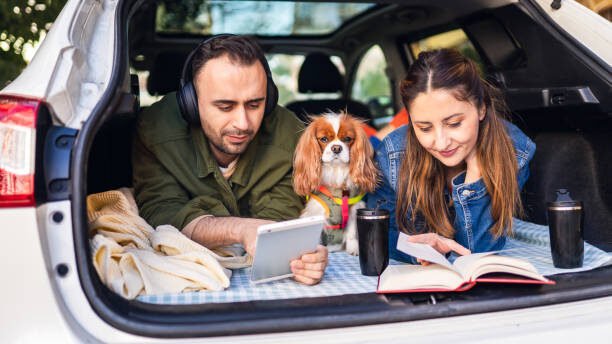Contents
- 1 10 Essential Tips for Car Camping with Dogs
- 1.1 1. Plan Your Route and Destination
- 1.2 2. Prepare Your Dog
- 1.3 3. Secure Your Dog in the Vehicle
- 1.4 4. Pick a Dogs-Friendly Campsite
- 1.5 5. Pick Your Dog’s Essentials
- 1.6 6. Provide Adequate Nutrition and Hydration
- 1.7 7. Take Regular Breaks
- 1.8 8. Watch out for Wildlife
- 1.9 9. Be Mindful of Weather Conditions
- 1.10 10. Enjoy the Adventure Together
- 1.11 FAQs
- 1.12 Q: Is car camping with dogs safe?
- 1.13 Q: What should I do if my dog gets anxious during car rides?
- 1.14 Q: Can I bring my dog on hiking trails while car camping?
- 1.15 Q: How can I prevent my dog from getting lost while camping?
- 1.16 Q: What should I do if my dog encounters wildlife while camping?
10 Essential Tips for Car Camping with Dogs
Car camping with dogs can be a fantastic adventure, but it requires careful planning and consideration to ensure the safety and comfort of your furry companion. Here are 10 essential tips to make your car camping trip with your dog enjoyable for both of you:

1. Plan Your Route and Destination
When planning your car camping with dog, it’s essential to research and plan your route carefully. Look for pet-friendly campgrounds along the way that offer amenities suitable for dogs, such as walking trails, pet-friendly facilities, and designated pet areas. Consider the distance you’ll be traveling each day and choose a destination that aligns with your dog’s needs and preferences.
2. Prepare Your Dog
Before Car Camping with Dogs, make sure your dog is prepared for the journey ahead. This includes ensuring they are up-to-date on vaccinations and packing all the essentials they’ll need during the trip, such as food, water, bedding, toys, and any medications they may require. Additionally, it’s a good idea to have a sturdy collar with identification tags containing your contact information in case your dog gets lost.
3. Secure Your Dog in the Vehicle
Safety should be a top priority when Car Camping with Dogs. Make sure your dog is secured properly using a harness, seat belt, or crate to prevent them from roaming around and causing distractions while you drive. This not only keeps your dog safe but also ensures the safety of everyone else in the vehicle.
4. Pick a Dogs-Friendly Campsite

Certainly! When choosing a dog-friendly campground, consider the following requirements:
- Pet-Friendly Policies: Ensure the campground has clear pet-friendly policies that allow dogs and specify any rules or restrictions regarding pets on the premises.
- Amenities for Dogs: Look for campgrounds that offer amenities specifically designed for dogs, such as designated pet areas, waste disposal stations, and dog-friendly trails or beaches.
- Safety Measures: Choose a campground that prioritizes the safety of pets, with features like secure fencing, well-maintained walking paths, and staff trained in pet emergency procedures.
- Accessibility: Opt for a campground with easy access to amenities and facilities for both humans and dogs, including water sources, restroom facilities, and pet-friendly accommodations.
- Reviews and Recommendations: Research campground reviews and seek recommendations from fellow pet owners to ensure a positive experience for you and your furry companion.
5. Pick Your Dog’s Essentials
Certainly! When packing for your pet’s essentials, consider including the following items:

-
- Food and Water: Pack enough of your pet’s regular food to last the duration of your trip, along with portable food and water bowls for feeding and hydration on the go.
- Leash and Collar: Bring a sturdy leash and collar with identification tags containing your contact information in case your pet gets lost during the trip.
- Bedding: Pack a comfortable blanket or bed for your pet to sleep on, providing them with a cozy place to rest at the campsite or in the car.
- Toys: Bring along a selection of your pet’s favorite toys to keep them entertained and stimulated during downtime at the campsite.
- Medications: If your pet requires any medications or supplements, be sure to pack an ample supply along with any necessary administration tools, such as syringes or pill pockets.
- First-Aid Kit: Prepare a pet-specific first-aid kit containing items such as bandages, antiseptic wipes, tweezers, and any medications your pet may need in case of emergencies.
- Waste Disposal Bags: Bring plenty of waste disposal bags to clean up after your pet and properly dispose of their waste while camping.
- Grooming Supplies: Pack grooming supplies such as brushes, nail clippers, and pet-safe shampoo to keep your pet clean and comfortable during the trip.
- Safety Gear: Consider bringing safety gear such as a reflective vest or light-up collar for nighttime visibility, especially if your pet will be off-leash at the campsite.
- Comfort Items: Don’t forget to include any comfort items that your pet may rely on, such as a favorite blanket, stuffed animal, or comforting scent to help them feel at ease in new surroundings.
6. Provide Adequate Nutrition and Hydration
Proper nutrition and hydration are crucial for your dog’s health and well-being during Car Camping with Dogs trip. Pack enough food and water to last the duration of your car camping adventure, and make sure your dog has access to clean water at all times to stay hydrated, especially during outdoor activities and hikes.
7. Take Regular Breaks
Taking regular breaks during your car camping with dog to stretch their legs, go for walks, and relieve themselves. Incorporate breaks into your travel itinerary to prevent your dog from becoming restless or anxious during long car rides. These breaks also give you an opportunity to bond with your dog and enjoy the journey together.
8. Watch out for Wildlife

When Car Camping with Dogs, it’s essential to watch out for wildlife to ensure the safety of both your pet and the local animals. Here are some tips to keep in mind:
-
- Leash Your Dog: Keep your dog on a leash at all times, especially in areas where wildlife may be present. This prevents your dog from chasing or disturbing wildlife and reduces the risk of encounters or conflicts.
- Stay Alert: Be vigilant and observant of your surroundings while hiking or exploring the wilderness with your dog. Keep an eye out for signs of wildlife activity, such as tracks, scat, or rustling in the bushes.
- Respect Wildlife Habitat: Avoid venturing into areas where wildlife is known to frequent, such as nesting sites or feeding grounds. Respect wildlife habitat by staying on designated trails and minimizing disturbances to their natural environment.
- Be Prepared: Familiarize yourself with local wildlife species and their behavior patterns before embarking on your camping trip. Know how to respond in the event of a wildlife encounter and have a plan in place to keep your dog safe.
- Make Noise: When hiking in areas with dense vegetation or limited visibility, make noise to alert wildlife of your presence and give them the opportunity to retreat. This helps prevent surprising or startling animals, reducing the likelihood of aggressive encounters.
- Avoid Feeding Wildlife: Refrain from feeding wildlife, as it can disrupt their natural feeding habits and create dependency on human food sources. Feeding wildlife also increases the risk of negative interactions between animals and humans.
- Be Cautious at Night: Exercise caution when camping or hiking at night, as wildlife activity may increase after dark. Keep your dog close and use a flashlight or headlamp to illuminate your surroundings, reducing the risk of unexpected encounters.
- Educate Yourself: Take the time to educate yourself about the wildlife species native to the area you’ll be camping in and learn how to coexist peacefully with local wildlife. Understanding their behavior and habits can help you avoid potential conflicts.
- Report Wildlife Sightings: If you encounter wildlife during your camping trip, report your sightings to park rangers or wildlife authorities. This helps them track animal populations and implement measures to ensure the safety of campers and wildlife alike.
9. Be Mindful of Weather Conditions
Weather conditions can impact your dog’s comfort and safety during the trip. Be mindful of extreme temperatures and provide adequate shelter and ventilation in the car or tent to protect your dog from heatstroke or hypothermia. Avoid leaving your dog unattended in hot cars or exposed to harsh weather conditions for extended periods.
10. Enjoy the Adventure Together
Above all, remember to have fun and enjoy the adventure together with your furry companion. Car camping with your dog offers a unique opportunity to bond and create lasting memories in the great outdoors. Embrace the experience, cherish the moments spent together, and make the most of your car camping adventure with your beloved canine companion
FAQs
Q: Is car camping with dogs safe?
Q: What should I do if my dog gets anxious during car rides?
Q: Can I bring my dog on hiking trails while car camping?
Q: How can I prevent my dog from getting lost while camping?
Q: What should I do if my dog encounters wildlife while camping?



Pingback: RV Camping with Dogs: Tips for a Paw-some Adventure 1
Pingback: Tips for Camping with Cat: The Adventurous Guide 1
Pingback: Solo Camping with your Dog: A Guide to Enjoying the Great Outdoors Together 1
Pingback: How to Camp in a Car: Ultimate Guide for Adventure Enthusiasts 1
Pingback: Ultimate Guide to Car Camping at Coachella: Tips & Essentials